
ORP Błyskawica is a Grom-class destroyer which served in the Polish Navy during World War II. She is the only Polish Navy ship to have been decorated with the Virtuti Militari, Poland's highest military order for gallantry, and in 2012 was given the Pro Memoria Medal. Błyskawica is preserved as a museum ship in Gdynia and is the oldest preserved destroyer in the world. Błyskawica is moored next to the Dar Pomorza.
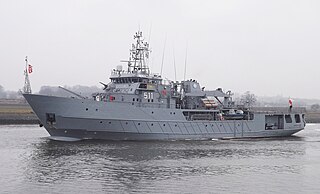
ORP Kontradmirał Xawery Czernicki is a mine countermeasure forces command vessel of the Polish Navy. The ship's design was based on a hull of the 130 class degaussing station planned by the Construction Bureau of the Refurbishing Shipyard in Gdańsk. The hull was ordered by the Russian Navy, but the contract was halted and it was decided to complete the ship for the Polish Navy. She was named after Rear Admiral Xawery Czernicki. The name is often written in a short form Kontradmirał X. Czernicki, even on the vessel's boards.
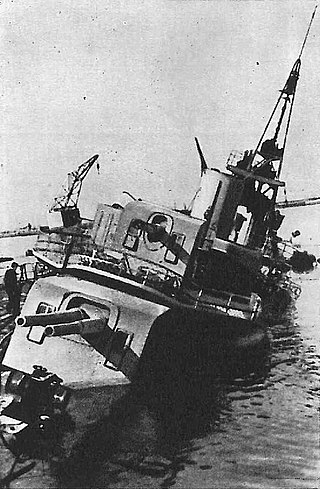
The Battle of Danzig Bay took place on 1 September 1939, at the beginning of the invasion of Poland, when Polish Navy warships were attacked by German Luftwaffe aircraft in Gdańsk Bay. It was the first naval-air battle of World War II.

The Project 206FM class, originally designated Project 206F, were mine-countermeasure vessels of the Polish Navy built during the mid-1960s.
ORP Gryf was a school and hospital ship of the Polish Navy, a second vessel to bear that name. She was built in German-occupied Denmark as a cargo ship in 1944, shortly before the end of World War II and initially named Irene Oldendorff. Soon after the capitulation of Germany, she was taken by the United Kingdom, passed to the Ministry of War Transport (MoWT) and renamed Empire Contees, but in 1946 it was given to the Soviet Union as part of that country's war reparations from Germany. Renamed Omsk (Омск), she served in the Soviet merchant fleet until 1947 when she was sold to Poland.
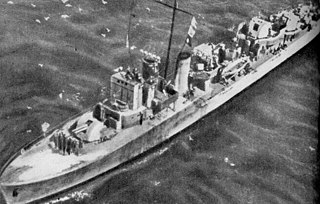
ORP Kujawiak was a British Type II Hunt-class destroyer escort, originally ordered as HMS Oakley.
This article details the order of battle of the Polish Navy prior to the outbreak of World War II and the Polish Defensive War of 1939. Following World War I, Poland's shoreline was relatively short and included no major seaports. In the 1920s and 1930s, such ports were built in Gdynia and Hel, and the Polish Navy underwent a modernisation program under the leadership of Counter-Admiral Józef Unrug and Vice-Admiral Jerzy Świrski. Ships were acquired from France, the Netherlands, and the United Kingdom, and the navy was to be able to secure the Polish supply lines in case of a war against the Soviet Union. By September 1939 the Polish Navy consisted of 5 submarines, 4 destroyers, and various support vessels and mine-warfare ships.
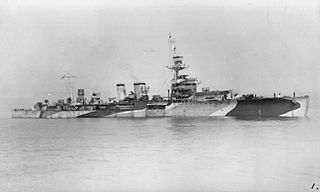
HMS Danae was the lead ship of the Danae-class cruisers, serving with the Royal Navy between the world wars and with the Polish Navy during the latter part of World War II as ORP Conrad.

Kormoran II - officially project 258, mine hunting type of vessels in building for the Polish Navy. The 2011 Defense Budget included a single vessel of this class. It was launched on 4 September 2015 and was predicted to enter service late 2016. Two more ships have been planned. Ships are built by Remontowa Shipbuilding Gdańsk and Naval Shipyard Gdynia consortium. It will be armed with a 35mm OSU-35K naval weapon station.
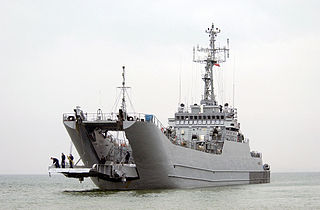
ORP Poznań(824) is a Lublin-class minelayer-landing ship of Polish Navy, named after the city of Poznań.
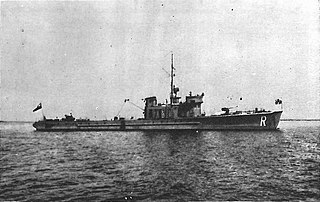
ORP Rybitwa was a Jaskółka-class minesweeper of the Polish Navy at the outset of World War II. Rybitwa participated in the defence of Poland during the Nazi German invasion of 1939. The ship was damaged by a German bomb on 14 September 1939. The ship was later captured by the Germans, but returned to serve under the Polish flag after the War.

The Polish Navy is the naval branch of the Polish Armed Forces. The Polish Navy consists of 46 ships and about 12,000 commissioned and enlisted personnel. The traditional ship prefix in the Polish Navy is ORP.

The Lublin class or Projekt 767 are minelayer-landing ships designed and built in Poland for the Polish Navy, in service since 1989. Only five out of the twelve planned ships were built, by the Northern Shipyard in Gdańsk, due to the fall of Communism. They can carry up to 9 T-72 tanks or 17 transport vehicles such as the Star 266 and 135 equipped troops. They were designed to carry up to 134 naval mines. The ships are named after the chief cities of the Piast dynasty.

ORP Gniezno(822) is a Lublin-class minelayer-landing ship of Polish Navy, named after the city of Gniezno.

ORP Kraków(823) is a Lublin-class minelayer-landing ship of Polish Navy, named after the city of Kraków.

ORP Toruń(825) is a Lublin-class minelayer-landing ship of Polish Navy, named after the city of Toruń.

ORP Mewa is a Polish base minesweeper from the Cold War era, one of a series of 12 vessels of Projekt 206F, converted between 1998 and 1999 to a minehunter of Projekt 206FM. The unit measured 58.2 meters in length, 7.97 meters in width, and had a draft of 2.14 meters, with a full displacement of 470 tons. It was armed with three double sets of 25 mm 2M-3M autocannons and depth charges, and was also adapted for transporting and deploying naval mines.

ORP Flaming was a Polish base minesweeper from the Cold War era, one of 12 ships of Projekt 206F, rebuilt between 2000 and 2001 into a minehunter. The vessel measured 58.2 meters in length, 7.97 meters in width, and had a draft of 2.14 meters, with a full displacement of 470 tons. It was armed with three twin-mounted 25 mm 2M-3M automatic guns and depth charges, and was also equipped to carry and deploy naval mines.

ORP Czajka is a Polish base minesweeper from the Cold War era, one of a series of 12 vessels of Projekt 206F, converted between 1998 and 1999 to a minehunter of Projekt 206FM. The unit measured 58.2 meters in length, 7.97 meters in width, and had a draft of 2.14 meters, with a full displacement of 470 tons. It was armed with three double sets of 25 mm 2M-3M autocannons and depth charges, and was also adapted for transporting and deploying naval mines.





















